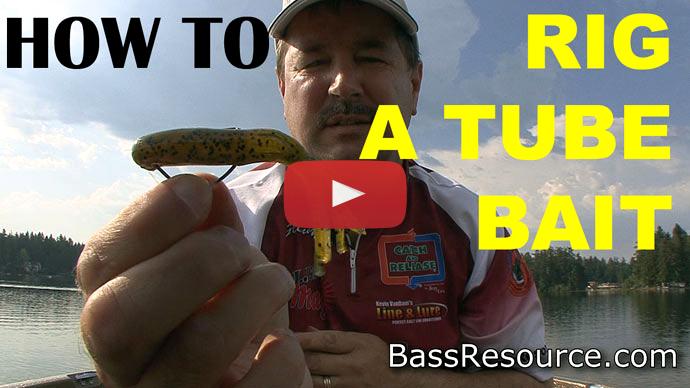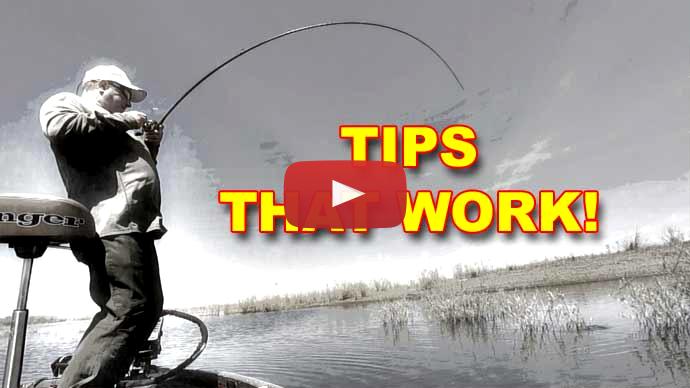Hey, guys. I'm Bassmaster Elite Series pro, Pat Schlapper with bassresource.com. Today I want to talk a little about kind of, I dunno if I'd call it a forgotten technique or lure, but it's just something that's kind of overlooked, in my opinion, a lot in the largemouth world. In the smallmouth world, it's an absolute staple. But in a largemouth world, you don't hear about it a whole lot, and that's a tube jig.
This is a Big Bite Tour Tube, and like I said, for smallmouth, most people are gonna put an insert head in there, cast out, drag it along on the rock, on the sand. It's something that every smallmouth fisherman who probably won't leave without.
But the one thing that I do a lot with it is I Texas rig it. And I really like to throw it around brush pile, offshore brush piles, and, you know, flip it in in pockets of weeds. Anywhere you would flip a jig on the bank or anywhere you would maybe, you know, fish a shakey head or something, a brush pile offshore, I'll throw a tube.
A lot of the reason why is because not many people throw it. And my setup's a little different. I've kind of spent a lot of years kind of, in my opinion, perfecting the hook, the rod, the reel, the line, and just the sinker setup. And one of the biggest components is the hook. So, this is actually, it's an Owner K-Hook and it's actually an inshore hook. You know, it's what a lot of people use to nose hook like a shiner under a bobber. This is a [inaudible 00:01:32], and they'll come just as a standard hook. But I have a good friend of mine who's a real talented fly tyer, and I'll have him tie a 20-pound fluorocarbon keeper on there. So, it's not real effective with other plastics, but with a tube, I'll show you why it's, in my opinion, the best hook if you're gonna Texas rig it.
So, you'll just take your bait like your, you know, standard Texas rig, pop it through, slide it over, up over that keeper, and that little plastic keeper will just slide up here. And when you pop that hook through, it just lays perfectly flat along the top of that tube. Sometimes I'll pop that thing back in just to hide it, but when that fish bites it, it almost acts like a circle hook, where when it bites and you set the hook, that rotates in and there's such a big gap in that hook. Most of the time that slides outta the way, and it's the best hookup ratio that I have found with a tube. And the stock bend of the hook, I'll actually bend that hook point up a little bit, about five degrees, just so it starts to penetrate the roof of the mouth a little bit sooner. So, that's the hook that I really like to use.
And the other key factor for this rig, with the exception of if I'm skipping up under docks, or under trees, or anything like that, 99% of the time I'm not gonna peg that sinker. I want it free. And I'll run anywhere from a 1/4 up to, you know, a 3/8-ounce sinker. And with that tube, what I really like is if I'm fishing over a brush pile, or whatever it is, I like that bait to come over and I like that sinker to separate and I like that to fall down first, and then that just lets that tube glide down and fall real slow and natural. And that's a lot of times, you know, when you'll get those bites.
So, I like to throw it on a St. Croix Legend Xtreme 7-foot, 4-inch heavy power, fast action. Stout rod, but it's got a little bit of a soft tip on there so you can still cast it good, but plenty of backbone to winch them out. I'll use 18 to 20-pound Sunline Shooter Fluorocarbon, once again, depending upon how heavy the cover it is.
And yeah, flip it, pitch it, drag it around. It's just a really effective technique that's often overlooked. And this is a standard like, you know, a cut tube where basically they'll mold this bait and then they cut the tentacles afterwards. And with this particular bait, in most cases, it's full of salt. So, it's real, real heavy. It's good for when a fish eats it, you know, they kind of have that salt taste, make them hold on a little bit longer.
But the one other bait in that category that, once again is kind of overlooked, it's gonna be a Craw Tube. And with the Craw Tube, this is from Big Bite, it's gonna be an injected bait. So, this, you know, if you see 'em out of the package, all these tentacles are the same because it's not cut afterwards.
This is actually how the mold is set up. It's injected into those tentacles. And there's also very little salt in it. There's some salt on the outside in the bag, but in the plastic, there's very little, if any, salt. So, what that does, is it makes it even more buoyant. So, now when you pull that thing over the brush pile and that sinker separates, this thing will really hang up and fall really, really slow, especially with them claws on there, bulk it up. I mean, it is absolutely deadly fishing on that Texas rig with the free sliding weight.
Now, great for flipping too. Pegging your sinker, flipping in pads, flipping in milfoil, skipping under docks, excellent for that. But on a free-sliding Texas rig, it's even better, in my opinion.



